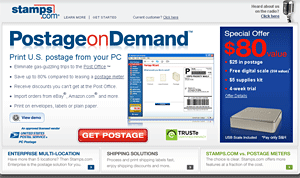Electronic Marketing is Marketing
I have been working with some new clients this month. Not only are they new to me, but they’re new to using the Internet for their own business.
My task has been to reassure them that everything they thought they know about marketing and sales still applies. The medium may be unfamiliar, but the basics of marketing are constant.
It’s been fun explaining to them that nothing fundamental is different. Here’s a great example from Inc.com.
Stamps.com found that using the phrase “sign up” was actually a negative; customers saw it as a high-pressure sales tactic. Once the site replaced that phrase with “Get Postage,” sales increased.
When the web site was focusing on what Stamps.com wanted (a new subscriber), visitors resisted. When the wording was rephrased to focus on delivering what the clients wanted (postage), people responded.
This is basic, brick-and-mortar, pre-Internet, pre-electricity marketing. You focus on meeting a need of your potential client and not on the needs of the business owner. Getting the prospect to sign-up will follow naturally once you’ve addressed his or her needs.
Your prospect’s time is valuable! They want to see that you’re going to solve their problem with little or no risk to them. They want to see this quickly.
So, on the Internet, just like in print, be direct, be catchy, and don’t waste anyone’s time or space.
“Welcome to our Website” is a very common — and very stupid — sight on the Internet. It’s like buying an ad in Time magazine that shouts in big type, “Welcome to our Ad”. Instead, spend your valuable screen real estate grabbing the prospect by his needs.
Don’t “welcome” or talk about yourself. Instead, make your visitors an offer they cannot refuse. Something like:
Contact Ozdachs for a FREE site analysis.





 Today’s ritual went okay until we were together on the recording device. The sales rep started reading the boilerplate contract which I would agree to at the end of his spiel.
Today’s ritual went okay until we were together on the recording device. The sales rep started reading the boilerplate contract which I would agree to at the end of his spiel.